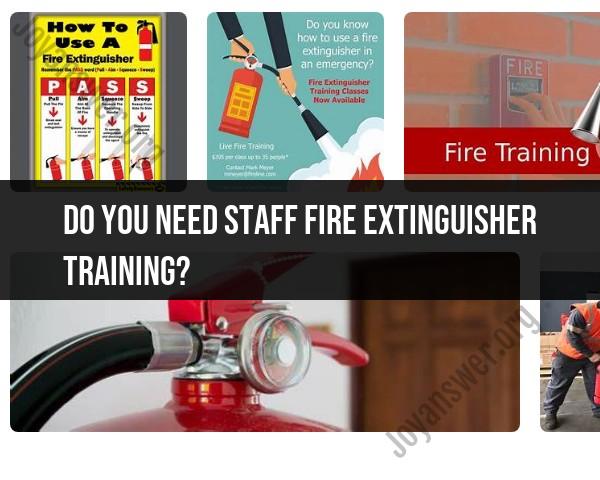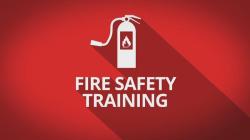Do you need staff fire extinguisher training?
Yes, staff fire extinguisher training is crucial for workplace safety. The proper use of fire extinguishers can be a critical factor in preventing small fires from escalating into larger, more dangerous incidents. Here are key reasons highlighting the importance of providing staff with fire extinguisher training:
1. Early Intervention and Fire Prevention:
- Staff trained in the use of fire extinguishers can intervene early during a fire incident, preventing the fire from spreading and potentially causing more significant damage.
2. Protection of Lives and Property:
- Prompt and effective use of fire extinguishers can protect lives and minimize damage to property. In some cases, a quick response with a fire extinguisher can extinguish a fire before the arrival of professional firefighters.
3. Emergency Preparedness:
- Training staff to use fire extinguishers enhances overall emergency preparedness. Employees become more familiar with evacuation procedures, emergency exits, and the appropriate steps to take during a fire emergency.
4. Reduced Fire Spread:
- Employees who are trained to use fire extinguishers can act swiftly to contain and extinguish small fires. This helps prevent the spread of fire to other areas within the building.
5. Compliance with Regulations:
- Occupational health and safety regulations in many regions require employers to provide fire safety training, including training on the use of fire extinguishers. Compliance with these regulations is essential to ensure a safe working environment.
6. Confidence and Competence:
- Training instills confidence in employees, making them more competent in responding to fire emergencies. Familiarity with fire extinguisher use increases the likelihood of effective intervention.
7. Risk Mitigation:
- Providing staff with fire extinguisher training is a proactive measure to mitigate the risk of fire incidents. Well-prepared employees are better equipped to handle emergencies and reduce potential risks.
8. Team Collaboration:
- Training sessions can promote team collaboration during emergencies. Employees learn to work together to assess the situation, determine the appropriate response, and use fire extinguishers effectively.
9. Understanding Fire Classes:
- Fire extinguisher training typically covers the different classes of fires (A, B, C, D, and sometimes K), ensuring that staff knows which type of extinguisher to use for specific types of fires.
10. Safe Evacuation Practices:
- In situations where the fire cannot be controlled with a fire extinguisher, trained staff members are better prepared to follow safe evacuation practices and assist others in evacuating the building.
11. Regular Refresher Training:
- Fire extinguisher training is not a one-time event. Regular refresher training sessions help reinforce skills, update employees on any changes in procedures, and ensure continued readiness.
12. Equipment Familiarity:
- Training ensures that employees are familiar with the types and locations of fire extinguishers in the workplace. This familiarity is crucial for a rapid response during an emergency.
13. Improved Overall Safety Culture:
- Implementing fire extinguisher training contributes to building a safety-conscious culture within the organization. Employees become more aware of potential fire hazards and take proactive measures to prevent incidents.
14. Emergency Response Coordination:
- Trained staff members can coordinate their responses during a fire emergency, ensuring that resources are utilized effectively and that communication is clear and organized.
15. Integration with Emergency Plans:
- Fire extinguisher training integrates with overall emergency response plans, providing a comprehensive approach to workplace safety.
In summary, staff fire extinguisher training is a critical component of workplace safety and emergency preparedness. It equips employees with the knowledge and skills needed to respond effectively to small fires, contribute to overall safety measures, and protect lives and property. Employers should prioritize providing regular training sessions and ensure that staff members are familiar with the proper use of fire extinguishers in their specific work environment.
Importance of Staff Fire Extinguisher Training: Skills, Frequency, & Benefits
1. Why Staff Fire Extinguisher Training is Essential:
Equipping staff with fire extinguisher training is essential for several reasons:
- Early fire response: Early intervention is crucial for controlling fires before they spread and cause significant damage. Staff trained in using fire extinguishers can effectively extinguish small fires, preventing them from escalating and protecting lives and property.
- Increased safety awareness: Training promotes fire safety awareness and helps employees identify potential hazards in the workplace. Understanding fire risks and prevention methods contributes to a safer overall environment.
- Improved confidence and preparedness: Knowing how to use a fire extinguisher effectively increases staff confidence in responding to fire emergencies. This reduces panic and allows them to act calmly and efficiently in critical situations.
- Compliance with regulations: Many industries and workplaces have legal requirements for staff fire extinguisher training. Ensuring compliance with these regulations reduces the risk of legal repercussions and protects the organization from liability.
- Reduced costs: Early fire control by trained staff minimizes potential damage to property and resources. This translates to reduced repair costs, business interruption, and overall financial losses.
2. Skills and Knowledge Imparted:
Fire extinguisher training typically covers the following skills and knowledge:
- Understanding fire types and extinguisher classes: Learn to differentiate between various fire types (Class A, B, C, D, K) and choose the appropriate extinguisher for each.
- Fire extinguisher operation: Receive hands-on training on how to use different types of fire extinguishers, including proper handling, aiming, and discharge techniques.
- Fire safety awareness: Gain knowledge about fire prevention strategies, hazard identification, and safe evacuation procedures.
- Decision-making and judgment: Develop the ability to assess fire situations, determine the appropriate response, and use fire extinguishers effectively.
- Basic first aid: Learn basic first aid skills to address potential injuries sustained during fire emergencies.
3. Training Frequency:
The recommended frequency for staff fire extinguisher training varies depending on factors such as:
- Industry regulations: Some industries have specific training frequency requirements mandated by regulations.
- Workplace fire hazards: The level of fire risk associated with the workplace and operations can influence training frequency.
- Staff turnover: New employees require initial training, necessitating more frequent sessions.
- Training effectiveness: Regular training ensures continued knowledge retention and skill development.
Generally, most organizations aim for annual fire extinguisher training for all staff. However, depending on the factors mentioned above, more frequent training (e.g., every 6 months) might be recommended. It's crucial to consult relevant regulations and assess individual workplace needs to determine the optimal training frequency.
By implementing regular and effective fire extinguisher training programs, organizations can empower their staff to be prepared in case of a fire emergency. This proactive approach can save lives, minimize damage, and contribute to a safer and more secure work environment.










